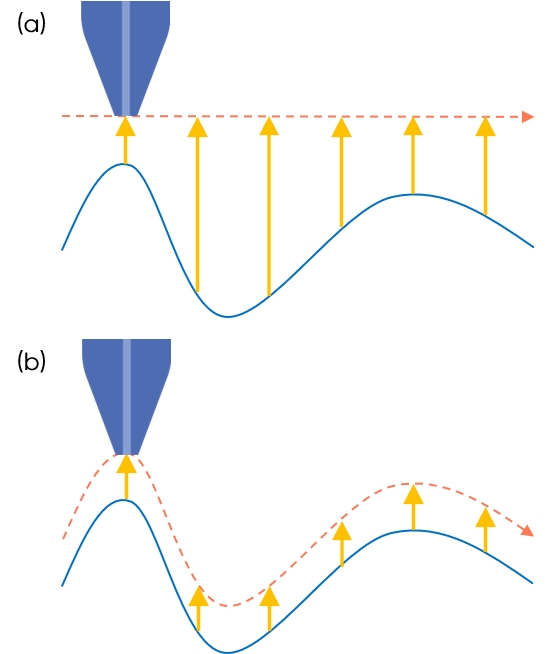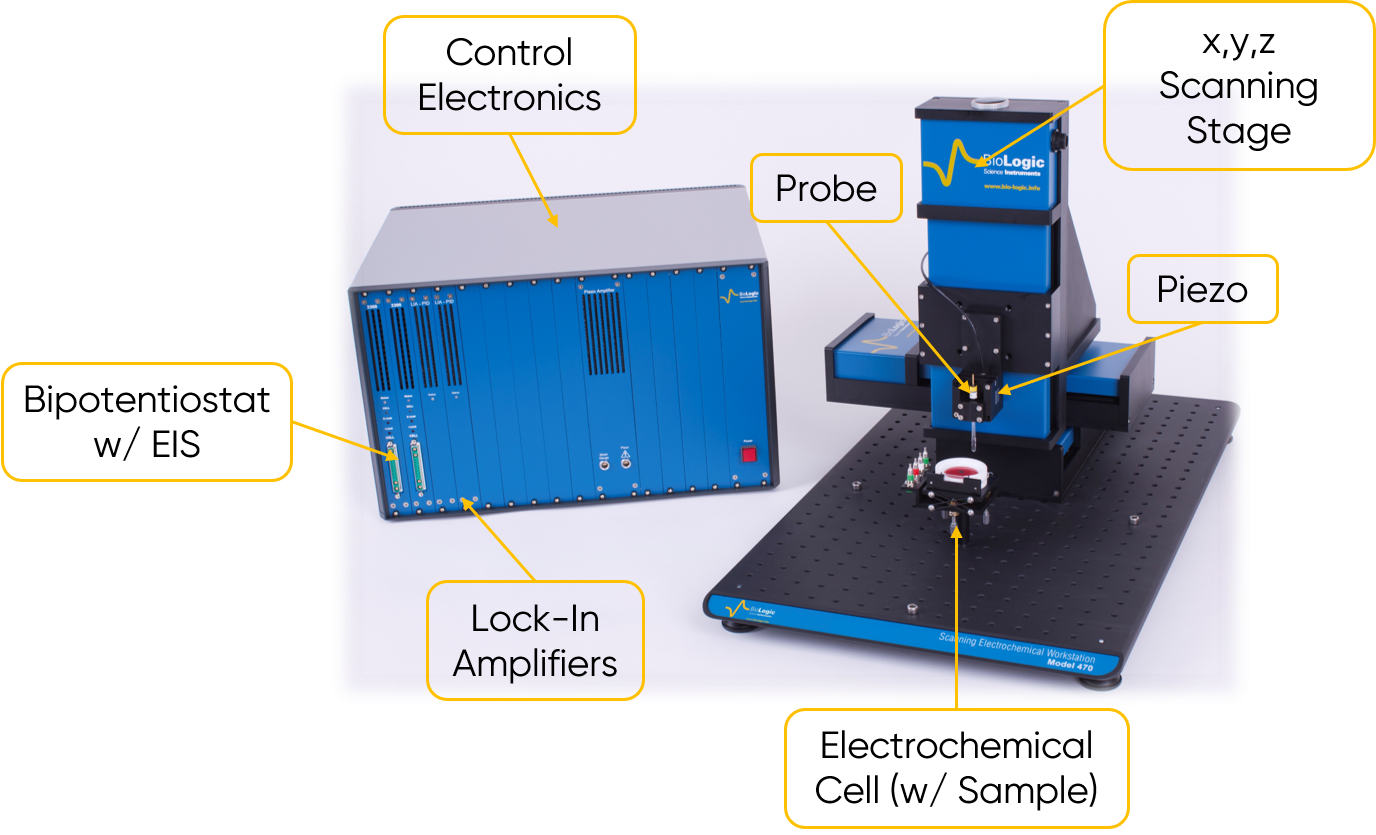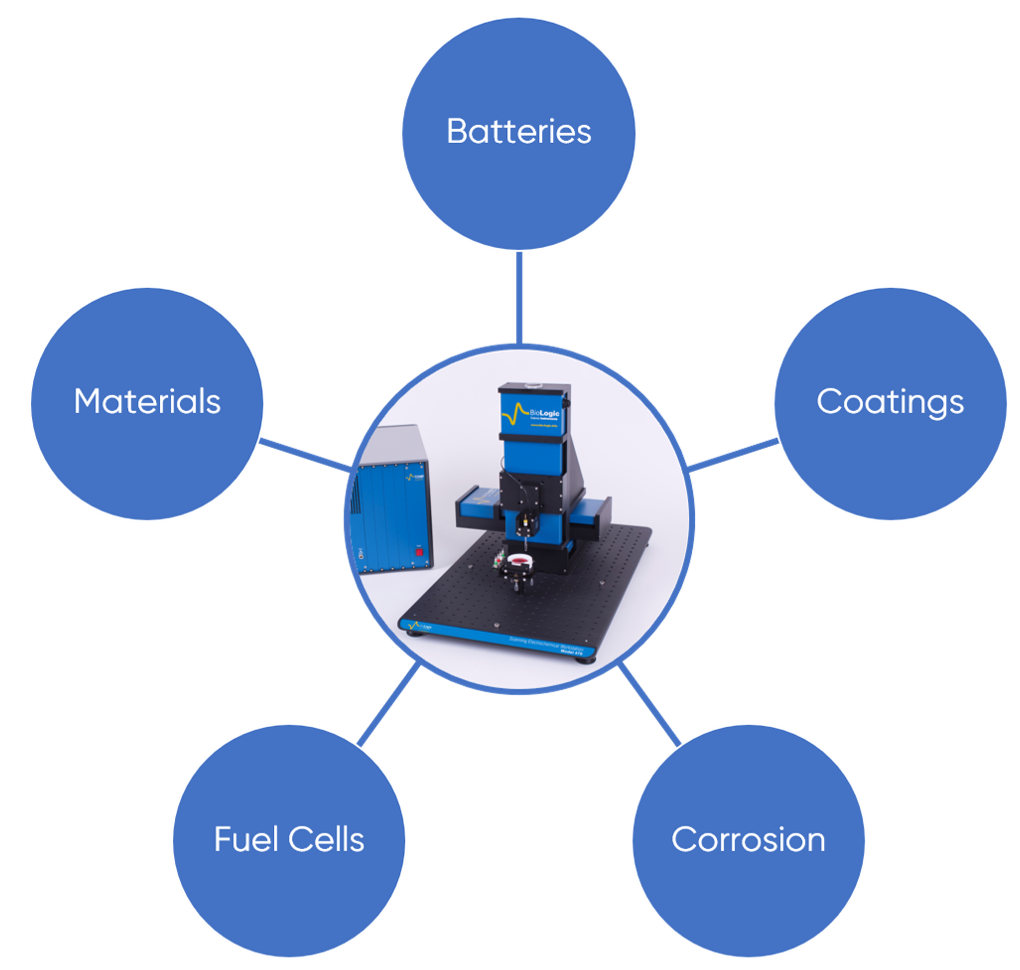ic-SECM101: An Introduction to Intermittent Contact-Scanning Electrochemical Microscopy
Latest updated: October 8, 2024What is Intermittent Contact-Scanning Electrochemical Microscopy?
Intermittent Contact-Scanning Electrochemical Microscopy (ic-SECM) is one of a number of constant distance SECM techniques. In ic-SECM, the probe is vertically vibrated to tap across the sample surface, following its topography throughout the measurement. This removes the influence of topography on the electrochemical response, which only depends on the sample activity. The ic-SECM technique was demonstrated by McKelvey et al. in 2010 [1] and introduced on a commercial instrument exclusively by BioLogic in 2013.
This article assumes knowledge of both the dc-SECM and ac-SECM techniques, for more information on these see the SECM101 and ac-SECM101 Learning Center articles. Information on other SECM types can also be found in a further Learning Center article explaining the different SECM types.
What is the difference between constant height and constant distance Scanning Electrochemical Microscopy?
In many scanning probe microscopy measurements, there are two options regarding how the probe behaves in z: (1) The probe can maintain the same z position throughout the measurement, meaning that changes in sample topography result in changes to the probe to sample distance, Fig. 1a. This is referred to as a constant height measurement. (2) The probe changes its z position throughout the measurement following the sample topography to maintain a constant probe to sample distance throughout, Fig. 1b. This is a constant distance measurement. In SECM, and other scanning probe microscopies for which the probe to sample distance can affect the signal of interest it can be advantageous to use a constant distance measurement to avoid the influence of topography on the resulting signal.

Figure 1 : In constant height measurements (a) the probe to sample distance (shown by the lengths of the yellow arrows)
changes, while the probe position (shown by the dashed red line) remains constant throughout. In constant distance measurements
(b) the probe to sample distance (shown by the lengths of the yellow arrows) remains constant throughout, while the probe position
(shown by the dashed red line) changes.
How does Intermittent Contact-Scanning Electrochemical Microscopy work?
In Intermittent Contact-Scanning Electrochemical Microscopy, the vertical probe vibration allows it to maintain close proximity to the sample surface throughout the duration of the measurement, to simultaneously collect topography and activity data. To achieve this a piezo is used to vibrate the probe sinusoidally at a known frequency, usually the resonant frequency of the vibrating device, and an amplitude which are set by the user. When the probe is in bulk solution the vibration amplitude is selected to be 1-4% of the active radius of the probe. This vibration amplitude, denoted as Δzbulk, is recorded accurately through the use of a strain gauge sensor. When the probe is near the sample surface, and intermittent contact is occurring, the vibration amplitude decreases, because this change in vibration amplitude can be accurately measured it can be used as a control point for the measurement. The control point vibration amplitude can be explicitly set by the user and is denoted as Δzic. Throughout the measurement as the probe moves to regions of higher or lower topography the measured vibration amplitude, Δzmeasured, changes. When the probe moves to a region of higher topography the vibration amplitude decreases so Δzmeasured < Δzic, this causes the probe to retract until Δzmeasured = Δzic. On the other hand, if the probe moves to a region of lower topography Δzmeasured > Δzic, and nears Δzbulk. In this case the probe approaches the surface until Δzmeasured = Δzic.
 Figure 2 : The probe behavior during the ic-SECM experiment is demonstrated.
Figure 2 : The probe behavior during the ic-SECM experiment is demonstrated.
What are the components of an Intermittent Contact-Scanning Electrochemical Microscope?
The components making up an Intermittent Contact-Scanning Electrochemical Microscope are shown in Fig. 3. An ic-SECM is composed of the basic components of an SECM instrument, including an x,y,z scanning stage, bipotentiostat, electrochemical cell, and probe. The scanning stage is capable of sub-micron step sizes and has highly repeatable movement to ensure the highest quality images. ic-SECM can be performed in either ac or dc mode, and therefore the bipotentiostat is capable of applying either an ac or dc bias to the probe. The second channel of the bipotentiostat can be used to apply a dc bias to the sample. The electrochemical cell is used to mount the sample, auxiliary electrodes, and electrolyte on the scanning stage. Unlike constant height SECM, ic-SECM does not require the cell to have a means of removing sample tilt. ic-SECM uses the same UltraMicroElectrode probe as constant height SECM. Further to these basic components an ic-SECM also requires additional hardware to achieve a controlled vibration in z. To vibrate the probe in a known manner a piezo is used, the addition of a strain gauge allows the change in vibration needed for the probe to detect the surface to be accurately measured. Throughout the measurement, a software regulation loop is used to ensure a constant vibration amplitude is maintained. The piezo is also used in ic-SECM to perform z positioning during the measurement. Lock-in amplifiers are included in ic-SECM to drive the oscillation of the probe and demodulate the ac signal which results from the probe vibration, to obtain the signal of interest.

Figure 3 : An Intermittent Contact-Scanning Electrochemical Microscope is annotated to show all of the components.
Why use Intermittent Contact-Scanning Electrochemical Microscopy?
Intermittent Contact-Scanning Electrochemical Microscopy builds on the many advantages seen by constant height ac- and dc-SECM. Unlike bulk techniques ic-SECM allows the local electrochemical characteristics of a sample to be measured and mapped without the need for sometimes difficult data interpretation to determine local effects. Of the scanning probe electrochemistry techniques SECM, of all kinds, has the particular advantage that it does not have an activity requirement for the sample. Instead, the sample can be anything from a completely insulating to a completely conducting sample. It can even be used to measure conductive regions fully isolated in an insulating matrix. This means SECM can be applied to samples that cannot be easily measured by bulk techniques because an electrical contact cannot easily be made, such as electrode arrays. As a constant distance technique ic-SECM has the advantage over the constant height SECM techniques in that the probe follows the sample topography throughout the measurement. While the signal in constant height SECM is a combination of sample topography and activity, in ic-SECM the signal measured is only a result of sample topography. Unlike some other constant distance SECM techniques ic-SECM also records the topography throughout the measurement. This results in both an activity output, and a topography output which are measured simultaneously in a single pass experiment allowing straightforward correlation of the two signals. Using ic-SECM measurements are performed with a much smaller probe to sample distance than achieved with constant height SECM measurements. This means that ic-SECM is capable of achieving a much greater contrast between active and inactive regions than would otherwise be possible. Finally, ic-SECM has the advantage that it uses the probe vibration to determine the probe to sample distance, allowing a push-button approach and removing the need for a traditional approach curve. Not only does this make the approach easier to achieve for new users, but it also allows a more straight forward approach in systems for which the mediator concentration is vanishingly low in bulk solution, for example, some generator collector experiments.

Figure 4 : The application areas in which ic-SECM has been used are shown.
Intermittent Contact-Scanning Electrochemical Microscopy has been demonstrated in local electrochemical studies of samples for which the influence of topography would make constant height SECM measurements impossible. The fields to which ic-SECM has been applied are shown in Fig. 4. Some examples of the application of ic-SECM include:
- Investigation of electrolytes for all-solid-state batteries [2]
- Map hydrogen for corrosion studies [3]
- Study the degradation of epoxies [4]
The uses of ic-SECM, and the other local electrochemical techniques, are covered in more detail in a set of Learning Center articles investigating the research questions which can be answered by these techniques.
Further Information
There is a growing number of resources available through BioLogic to increase your understanding of the ic-SECM technique, including application notes, and tutorials. Be sure to keep checking back on our Learning Center for more information as new articles are regularly added.
References
- McKelvey, M. A. Edwards, P. R. Unwin, Anal. Chem. 82 (2010) 6334–6337
- Takami, Y. Morita, M. Yonemura, Y. Ishikawa, S. Tanaka, M. Mori, T. Fukunaga, E. Matsubara, ACS Appl. Energy Mater. 1 (2018) 2546–2554
- C. Lafouresse, M.-L. de Bonfils-Lahovary, L. Laffont, C. Blanc, Electrochem. Comm. 80 (2017) 29-32
- Morimoto, A. Fujimoto, H. Katoh, H. Kumazawa, AIAA Scitech 2019 Forum, 7-11 January 2019, San Diego, California





